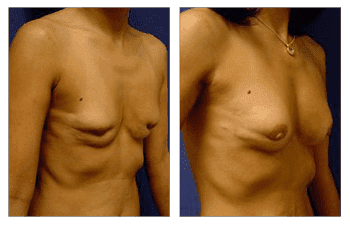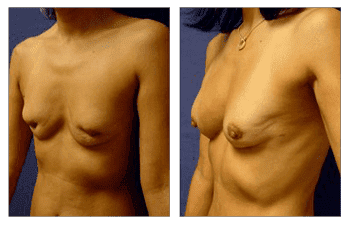



Introduction: Fat transfer following Breast Implant Removal
Fat transfer following implant removal is a unique option for patients who wish to eliminate silicone from their bodies. Historically, fat transfer following implant removal has been a routine procedure for buttock enhancement patients. Many patients who had previous buttock implants inserted have experienced complications relating to their buttock implants thus necessitating buttock implant removal; the routine remedy has been the replacement of the volume with fat graft transfer. Recently, this buttock procedure has been extended to the breasts.
Dislike for breast implants has become even more recently popularized by Breast Implant Illness Syndrome. Patients with breast implants across the United States have been commiserating around nonspecific symptoms that they attribute to the silicone in their implants. Symptoms have ranged from nonspecific aches and pains not isolated to the breast but spreading across the whole body and joints.
They are also showing a proclivity to auto-immune-related illnesses that they fear are related to immune cell reactions to silicone molecules. Although Breast Implant Illness has not been scientifically proven, it has become undeniably very concerning. As such, we are routinely asked today to perform fat transfer following implant removal. A final scare regarding breast implants has stemmed from a rare but unique lymphoma associated with textured silicone breast implants.
Fat Transfer Following Breast Implant Removal Case Study
The patient is seen here presented with a case of breast deformities following a breast implant augmentation performed by a prior surgeon. The patient presented with capsular contracture after implant placement, so implants were removed. When implants are removed, and as can be seen here, there is a maximum collapse of breast tissues right under the areola.
The patient is seen here presented with a case of breast deformities following a breast implant augmentation performed by a prior surgeon. The patient presented with capsular contracture after implant placement, so implants were removed. When implants are removed, and as can be seen here, there is a maximum collapse of breast tissues right under the areola.
The divots on the breasts demonstrate this collapse of tissue. Fat transfer following implant removal allowed board-certified plastic surgeon, SurgiSculpt, to correct the breast deformity, eliminating divots of the periareolar area, and providing the patients with symmetrical, aesthetic breasts with some volume to correct the collapse.
What are the indications for breast implant removal surgery?
Breast implant removal surgery, also known as explantation, is performed for a variety of reasons. Whether it’s due to complications with implants, changes in personal preferences, or health concerns, there are specific indications that may warrant the need for breast implant removal.
Understanding these indications is crucial for individuals considering this procedure, as it can provide insight into potential risks and benefits, as well as ensure that the decision aligns with their personal and medical needs. By exploring the indications for breast implant removal surgery, individuals can make informed decisions about their breast health and overall well-being.
A change in cup size
For women looking to change their cup size from a larger to a more natural look, there are a few possible steps and options to consider. One option is to undergo a breast implant removal surgery to downsize the implants or remove them altogether. Another option is to replace the large implants with smaller ones to achieve a more proportionate and natural look.
Large implants can cause discomfort such as back, shoulder, and neck pain, as well as interference with physical activities and difficulty finding well-fitting clothes. Changing to a smaller cup size may alleviate these issues and improve comfort and mobility.
When considering a change in cup size, factors to consider include the desired cup size, recovery time, potential risks of surgery, and the expertise of the plastic surgeon. It is important for women to carefully weigh the pros and cons and consult with a trusted medical professional to determine the best course of action for their circumstances.
In conclusion, women looking to change their cup size should carefully consider their options and potential discomfort caused by large implants, to achieve a more natural look and improved comfort.
Capsular contracture
Capsular contracture occurs when scar tissue forms around a breast implant, causing the tissue to harden and potentially distort the shape of the breast. Treatment options for capsular contracture include surgery to remove the hardened scar tissue, known as a capsulectomy, or to change the position of the implants. Another option is a procedure called a capsulotomy, where the surgeon makes incisions in the scar tissue to release the constriction.
Potential risks and complications associated with these treatments include infection, bleeding, changes in nipple sensation, and the need for additional surgeries. In some cases, the condition may recur even after treatment.
Factors that may increase the risk of developing capsular contracture include infection or bleeding during surgery, implant rupture, smoking, and a history of radiation therapy.
It’s important to discuss all potential risks and benefits with a board-certified plastic surgeon when considering treatment for capsular contracture. Each case is unique, and the right course of action will depend on individual circumstances and the severity of the condition.
Implant rupture
mplant rupture can occur in both saline and silicone implants, but the potential risks and symptoms differ between the two types. In saline implants, a rupture may result in immediate deflation of the breast, causing a noticeable change in size and shape. On the other hand, silicone implant ruptures are often silent, with no obvious external symptoms. This makes it crucial for individuals with silicone implants to undergo regular imaging tests, such as MRI or ultrasound, to detect ruptures.
Symptoms of silicone implant rupture may include pain, swelling, and changes in breast shape, but these can often be subtle and easily overlooked. Individuals need to seek immediate medical attention if they suspect a rupture, as leaving it untreated can lead to silicone migration, inflammation, and scarring around the implant. Additionally, silicone leakage may spread to other parts of the body, causing potential health risks.
In conclusion, while saline implant ruptures may be more immediately noticeable, the silent nature of silicone ruptures necessitates regular imaging tests and prompt medical attention if a rupture is suspected. It is important for individuals with breast implants to be aware of the potential risks and symptoms of implant rupture and to seek medical care as soon as possible if necessary.
Implant malposition
Implant malposition can occur due to a variety of factors, including poor surgical technique, implant size, and weight fluctuations. Poor surgical technique during the initial implant placement can lead to improper positioning, which may result in migration of the implant over time. Additionally, significant weight fluctuations can cause the implants to shift or move out of their intended position.
Consequences of implant malposition can range from aesthetic dissatisfaction to physical discomfort and even serious health issues. Patients may experience asymmetry, rippling, or distortion of the breast shape due to implant malposition. In severe cases, malposition can also lead to implant rupture or exposure, leading to potential infections and the need for corrective surgery.
Patients experiencing implant malposition should seek professional medical advice promptly. A skilled plastic surgeon can assess the situation and recommend the best course of action, which may include corrective surgery to reposition or replace the implants. Patients must address implant malposition with professional medical guidance to ensure effective and safe resolution of the issue.
BII and BIA-ALCL
Breast Implant Illness (BII) and Breast Implant-Associated Anaplastic Large Cell Lymphoma (BIA-ALCL) are two potential complications associated with breast implants, particularly with textured implants. Symptoms of BII can include fatigue, chest pain, joint pain, hair loss, and cognitive dysfunction. On the other hand, BIA-ALCL may present with swelling, pain, and lumps around the breast implant.
Surgical recommendations for both BII and BIA-ALCL include implant removal and total capsulectomy, which is the complete removal of the scar tissue capsule surrounding the implant. This is essential to address the potential health risks and provide relief from symptoms. The link to textured implants emphasizes the importance of thorough surgical intervention to minimize the risk of recurrence.
It is crucial for patients experiencing symptoms or diagnosed with BIA-ALCL to consult with a qualified healthcare provider for proper evaluation and personalized treatment recommendations. Textured implant removal and total capsulectomy may be the best course of action to address these issues and restore the patient’s health and well-being.
Implant rippling
If you are experiencing implant rippling, the first step is to consult with a plastic surgeon to evaluate the thinness of your breast skin. They will be able to assess the situation and determine the best course of action. This may involve considering the option of replacing the implants with either silicone or saline implants to address the issue of rippling.
In some cases, the surgeon may also discuss the possibility of a fat transfer to provide additional padding and support for the implants. This can help prevent future rippling and provide a more natural look and feel.
It’s important to also consider the potential for stretched-out skin, the risk of implant rupture, and the need for breast implant revision in the future. These factors will play a role in determining the best approach for addressing implant rippling.
Ultimately, a consultation with a plastic surgeon will provide you with a personalized plan to address your specific concerns and achieve the desired results.
How is Fat Transfer following implant removal performed?
Fat transfer following implant removal is a plastic surgery procedure that involves the removal of breast implants and the transfer of the patient’s own body fat to enhance the appearance of the breasts. This technique is often chosen by individuals who want to maintain a natural look and feel to their breasts after having their implants removed. The procedure is performed by first removing the implants and then using liposuction to harvest fat from other areas of the body, such as the abdomen or thighs.
The harvested fat is then processed and injected into the breasts to achieve the desired volume and shape. This innovative approach not only allows patients to regain their natural breast shape but also offers the added benefit of body contouring through fat removal from unwanted areas. The entire process is carefully tailored to meet the individual’s aesthetic goals while providing a more natural and customized breast enhancement solution.
Techniques
used in the lipomatic breast explantation and power-assisted transfer of autologous fat to the breast procedure.
The lipomatic breast explantation and power-assisted transfer of autologous fat to the breast procedure involve several key techniques. Firstly, ultrasound-guided nerve blocking is used for anesthesia to minimize discomfort during the procedure. This technique allows for precise targeting of nerves to ensure effective pain relief.
Incision placement is carefully planned to minimize scarring and achieve optimal access for implant removal and fat injection. Implant replacement is performed if desired, and the incisions are closed with meticulous attention to detail.
During the procedure, autologous fat is harvested using lipomatic technology, which allows for precise and controlled removal of fat cells. The harvested fat is then purified to separate viable fat cells from other components.
Finally, the purified fat is injected into the breasts using a power-assisted transfer technique. This ensures a uniform and natural-looking result, with the fat distributed evenly throughout the breast tissue.
Overall, the lipomatic breast explantation and power-assisted transfer of autologous fat to the breast procedure combines advanced techniques to achieve safe and aesthetically pleasing results.
Results
In a study of 100 female patients undergoing breast augmentation, the mean age was 32 years, with a mean BMI of 23. The mean injection volume was 300 mL per breast, and the mean implant volume was 350 mL. The patients were followed up for an average of 2 years. The study found that 10% of patients experienced complications, including infection and implant rupture. However, 90% of patients reported being satisfied with the procedure and the overall outcome. The demographics of the study group reflected a diverse range of ethnicities and socioeconomic backgrounds. In conclusion, the study demonstrated a relatively low incidence of complications and high patient satisfaction rates among a diverse group of patients undergoing breast augmentation.
What Size Breasts Can I Achieve with Fat Transfer?
Fat transfer for breast augmentation can achieve a range of sizes depending on factors such as the individual’s anatomy and the amount of available fat for transfer. Generally, fat transfer can result in a moderate increase in breast size, typically one to two cup sizes. It is important to note that not all individuals will be able to achieve their desired breast size with fat transfer alone, and in some cases, the procedure may need to be performed in stages to achieve the desired result.
In cases of restoring breast volume after explant surgery, fat transfer can be a suitable option. The procedure involves harvesting fat from other areas of the body through liposuction, purifying the fat, and strategically injecting it into the breasts to create a natural and fuller appearance. The process is performed under local anesthesia and has minimal downtime.
Overall, fat transfer can provide a natural-looking increase in breast size, especially for individuals seeking a modest augmentation or restoration of breast volume after explant surgery. It is a safe and effective option for those looking for a more subtle change in breast size.
What Maintenance Is Needed After Fat Transfer?
After undergoing fat transfer, minimal maintenance is required due to the long-lasting results and lack of additional surgery needed. Unlike traditional implants, fat transfer provides a natural and permanent solution, eliminating the need for regular replacements or adjustments. However, it is important to maintain a stable weight to ensure the longevity of the fat transfer. Fluctuations in weight can affect the volume and shape of the transferred fat, potentially impacting the overall results.
Additionally, fat transfer is a beneficial option for those considering breast implant removal. It allows for a natural, feminine appearance without the need for synthetic implants. Furthermore, the donor regions, such as the abdomen or thighs, may experience a slimming and contouring effect as a result of the fat removal, providing an overall aesthetic enhancement. Overall, fat transfer offers a low-maintenance and long-lasting solution for those seeking natural and sustainable results.
Conclusion: Fat Transfer after Breast Implant Removal
In conclusion, fat transfer after breast implant removal offers numerous benefits, including a more natural look and feel, minimization of scarring, and the potential for simultaneous body contouring through the use of excess fat from other areas. However, it’s important to consider the limitations of fat transfer in correcting sagging that may result from implant removal. In some cases, a breast lift may be necessary to achieve optimal results.
Women may choose to remove their breast implants for a variety of reasons, including dissatisfaction with the appearance or feel of the implants, implant rupture or leakage, capsular contracture, or ongoing complications that require revision surgery.
To achieve optimal results after implant removal, a combination of lift and enhancement with fat transfer may be the most effective approach. This can address both sagging and volume loss, ultimately providing a more natural and aesthetically pleasing outcome. It’s important for women considering this option to consult with a board-certified cosmetic or plastic surgeon to explore the best options for their individual needs.
If you are interested in a fat transfer following implant removal, please contact our office, SurgiSculpt, in Newport Beach, CA at (949) 499-4147; we offer complimentary virtual and in-person consultations.
